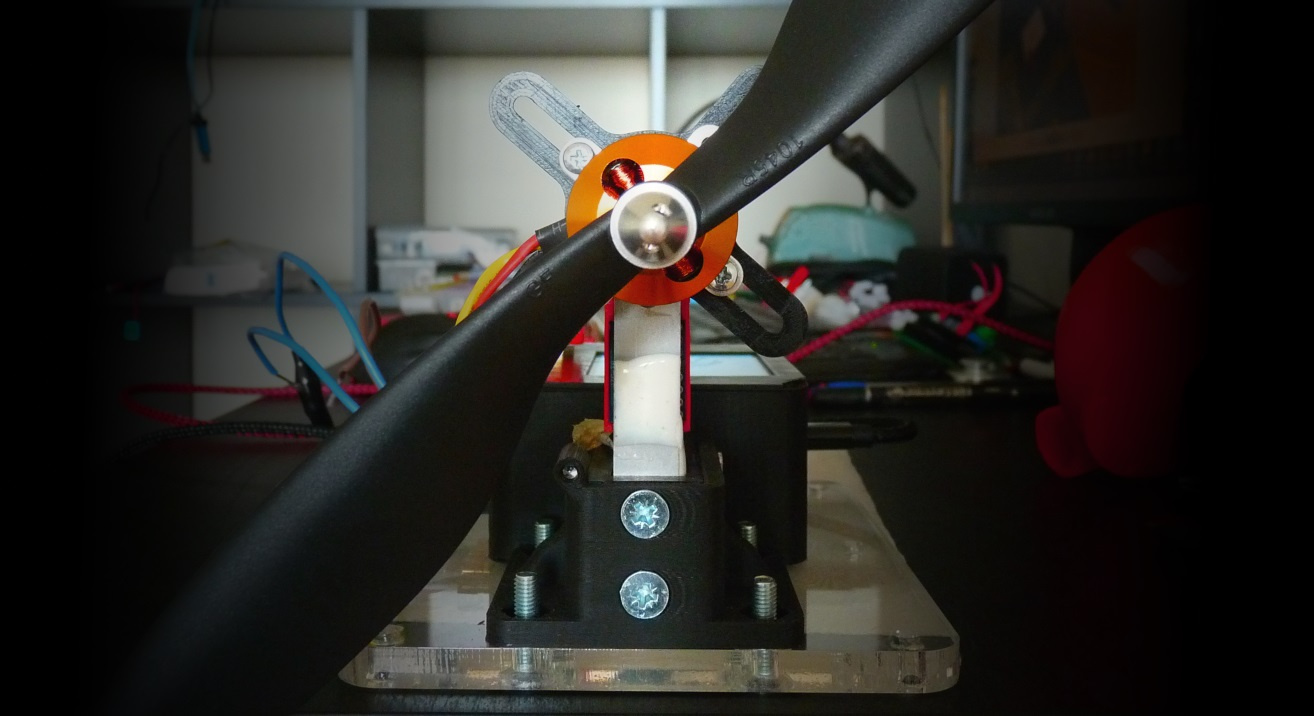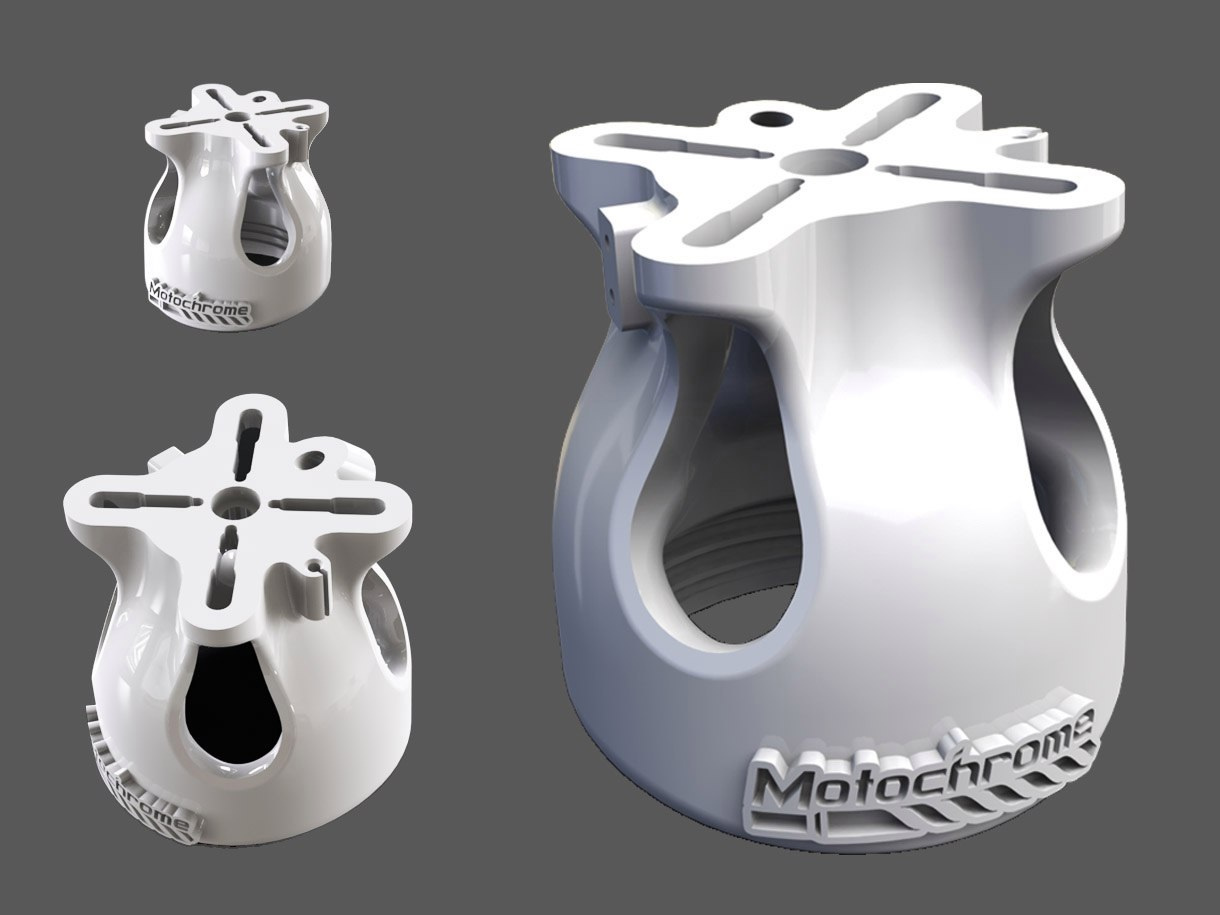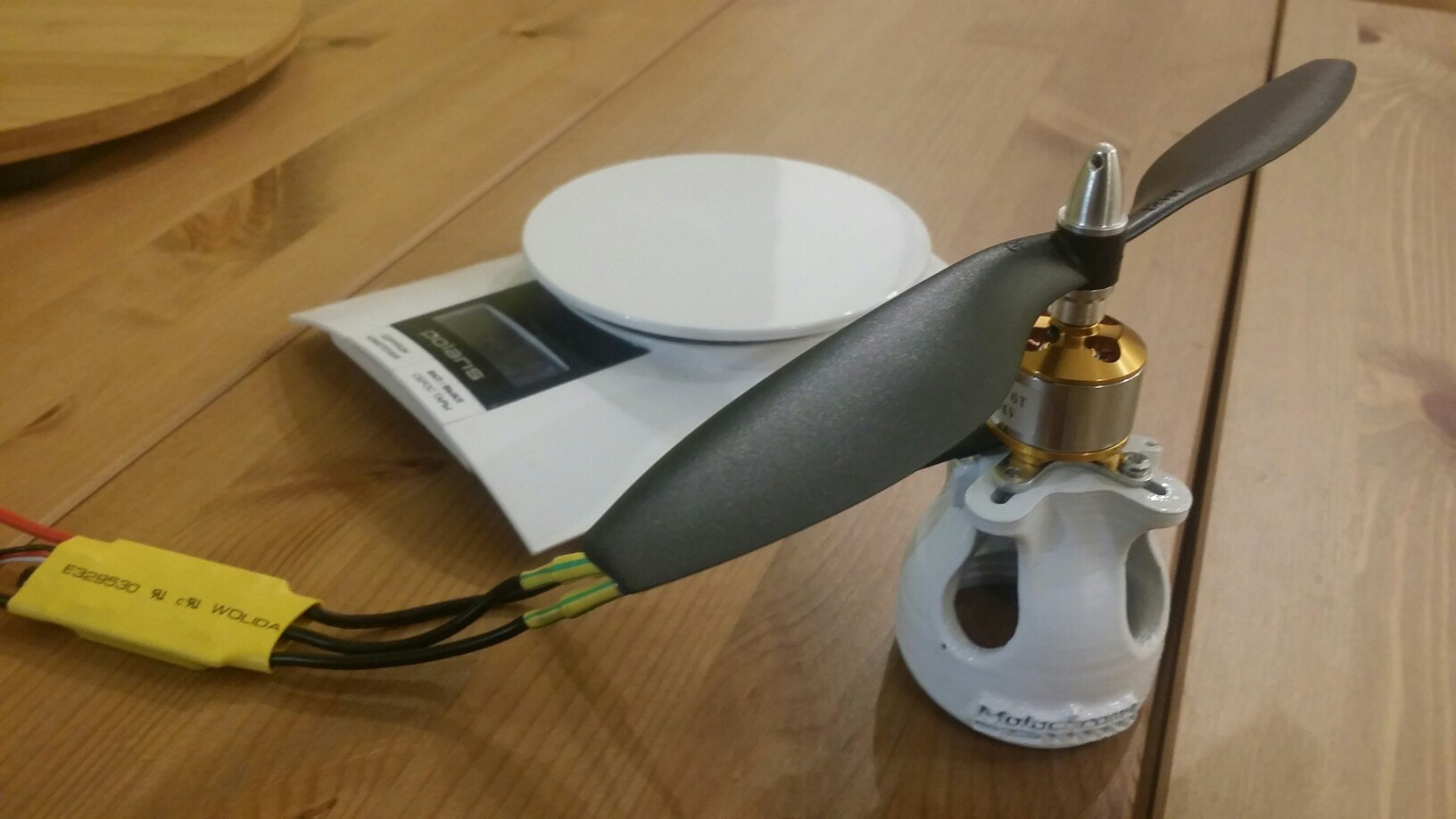Efficient quadrocopter
When creating a copter, one of the most important parameters is the autonomous flight time. If you want your copter to fly as long as possible, the motors and their rotors should work in optimal mode with maximum efficiency. To solve this problem, we designed a special measuring stand, which will be discussed in this article.

We are engaged in the creation of brushless motors and recently we had an order for a motor for a quadrocopter with a thrust of at least 2 Kg per screw. Before that, we did not make motors for a propeller and we needed a measurement method and a stand for a motor with a propeller.
Before you begin to choose the best motor and screw for it, you first need to figure out what losses occur in the motors.
The main sources of losses in brushless motors are the stator iron and its winding.
Losses on iron arise due to its magnetization reversal. These losses can conditionally be considered proportional to the engine speed and they specify the minimum energy consumption of the motor. So, for example, if you take a large and powerful motor for a small copter with a small propeller, then you will not succeed. The motor will simply idle at zero efficiency and warm the iron in the stator.
Losses in copper wire, on the contrary, are independent of revolutions, but depend on current / power consumption. These losses limit the maximum power that the motor can give out without overheating.
The second important element when choosing a motor is the screw. Small propellers have lower g / W performance (1 gram of lift / 1 Watt power consumption), but small propellers are more dynamic and allow you to quickly gain speed on racing copters. To achieve maximum flight time, the propeller must correspond to the maximum effective motor operation mode.
However, if we want to choose the optimal components for our copter, then we will face a big problem when choosing them. Manufacturers give a minimum set of characteristics for their product. On the screws it is generally impossible to find any information other than their size.
Stand functionality
At the moment, several manufacturers have already presented their stands on the market. However, their capabilities do not greatly exceed the functionality of the kitchen scale. And these stands are not able to give all the characteristics of the motor.
We from the stand needed the following parameters: power consumption, engine speed, propeller thrust, torque created by the propeller, motor efficiency, motor efficiency, propeller.
Based on these parameters, we designed the stand design and supplied it with all the necessary sensors.

To measure the traction force and moment, we selected the now widely used sensors with strain resistance. They have good rigidity and high measurement accuracy and are very well suited in their design.
To measure the remaining parameters, we selected standard sensors for this: semiconductor thermal resistance for temperature, an accelerometer for measuring vibrations, a current sensor on the hall effect for measuring current and a voltage divider ... The
heart of our stand is the ATMega328 microcontroller on the Arduino Nano board. It collects readings from sensors, processes them and displays on the screen. This microcontroller is optimally suited for this task. It has a minimum price, is not picky about food, is stable and has a sufficient number of interfaces for this task.
As a result of our work, a stand was obtained with the following parameters:
Testing
We tested our stand on the widespread Chinese motor 2212 and on our motor.

The Chinese motor in the entire range could not give an efficiency above 50%, and its efficiency was about 4-5g / watt. Ours was able to show an efficiency above 70%, while it worked at the minimum of its power (the test was at its peak up to 500W, the theoretical maximum was 1500W), because the size of the tested screw is small for it and with a larger screw the efficiency will only increase. Efficiency, however, turned out to be 9g / watt. So even taking into account the much larger weight of the engine, even a small copter with our engine could fly longer.) The
economical option The
stand described in this article is quite complex and is designed to accurately work out the power units of the drone. For the case when you want to save money and find out just the thrust of the motor, we made a simple, cheap adapter capable of performing this function.

This adapter is attached at one end to the motor, the other to a water bottle. The bottle is mounted on the scale. Next, the motor starts and thrust is measured according to the readings of the balance.

The mount on the adapter is made universal and fits almost all common motors. At the second end of the adapter there is a thread for screwing onto a 5 liter bottle.

We are engaged in the creation of brushless motors and recently we had an order for a motor for a quadrocopter with a thrust of at least 2 Kg per screw. Before that, we did not make motors for a propeller and we needed a measurement method and a stand for a motor with a propeller.
Before you begin to choose the best motor and screw for it, you first need to figure out what losses occur in the motors.
The main sources of losses in brushless motors are the stator iron and its winding.
Losses on iron arise due to its magnetization reversal. These losses can conditionally be considered proportional to the engine speed and they specify the minimum energy consumption of the motor. So, for example, if you take a large and powerful motor for a small copter with a small propeller, then you will not succeed. The motor will simply idle at zero efficiency and warm the iron in the stator.
Losses in copper wire, on the contrary, are independent of revolutions, but depend on current / power consumption. These losses limit the maximum power that the motor can give out without overheating.
The second important element when choosing a motor is the screw. Small propellers have lower g / W performance (1 gram of lift / 1 Watt power consumption), but small propellers are more dynamic and allow you to quickly gain speed on racing copters. To achieve maximum flight time, the propeller must correspond to the maximum effective motor operation mode.
However, if we want to choose the optimal components for our copter, then we will face a big problem when choosing them. Manufacturers give a minimum set of characteristics for their product. On the screws it is generally impossible to find any information other than their size.
Stand functionality
At the moment, several manufacturers have already presented their stands on the market. However, their capabilities do not greatly exceed the functionality of the kitchen scale. And these stands are not able to give all the characteristics of the motor.
We from the stand needed the following parameters: power consumption, engine speed, propeller thrust, torque created by the propeller, motor efficiency, motor efficiency, propeller.
Based on these parameters, we designed the stand design and supplied it with all the necessary sensors.

To measure the traction force and moment, we selected the now widely used sensors with strain resistance. They have good rigidity and high measurement accuracy and are very well suited in their design.
To measure the remaining parameters, we selected standard sensors for this: semiconductor thermal resistance for temperature, an accelerometer for measuring vibrations, a current sensor on the hall effect for measuring current and a voltage divider ... The
heart of our stand is the ATMega328 microcontroller on the Arduino Nano board. It collects readings from sensors, processes them and displays on the screen. This microcontroller is optimally suited for this task. It has a minimum price, is not picky about food, is stable and has a sufficient number of interfaces for this task.
As a result of our work, a stand was obtained with the following parameters:
- Power supply via BEC 5-9V controller module, or via micro USB
- Traction measurement up to 5kg with an accuracy of + -5g
- Torque measurement up to 3Kg / cm with accuracy + -5g / cm
- Voltage measurement up to 30V with accuracy + -0.2V
- Current measurement up to 30A with an accuracy of + -0.1A
- Efficiency measurement with accuracy + -2.5%
- The ability to measure screw speed in the range of 1000-15000RPM
- Ability to measure relative vibrations. (You can use this parameter to balance the motor with the screw by reducing the vibration parameter)
- Measurement of the temperature of the motor (* currently not fully implemented in the stand, we used a separately connected sensor)
- The ability to control the gas pedal directly from the remote
Testing
We tested our stand on the widespread Chinese motor 2212 and on our motor.

Video Test Example
The Chinese motor in the entire range could not give an efficiency above 50%, and its efficiency was about 4-5g / watt. Ours was able to show an efficiency above 70%, while it worked at the minimum of its power (the test was at its peak up to 500W, the theoretical maximum was 1500W), because the size of the tested screw is small for it and with a larger screw the efficiency will only increase. Efficiency, however, turned out to be 9g / watt. So even taking into account the much larger weight of the engine, even a small copter with our engine could fly longer.) The
economical option The
stand described in this article is quite complex and is designed to accurately work out the power units of the drone. For the case when you want to save money and find out just the thrust of the motor, we made a simple, cheap adapter capable of performing this function.

This adapter is attached at one end to the motor, the other to a water bottle. The bottle is mounted on the scale. Next, the motor starts and thrust is measured according to the readings of the balance.

The mount on the adapter is made universal and fits almost all common motors. At the second end of the adapter there is a thread for screwing onto a 5 liter bottle.
